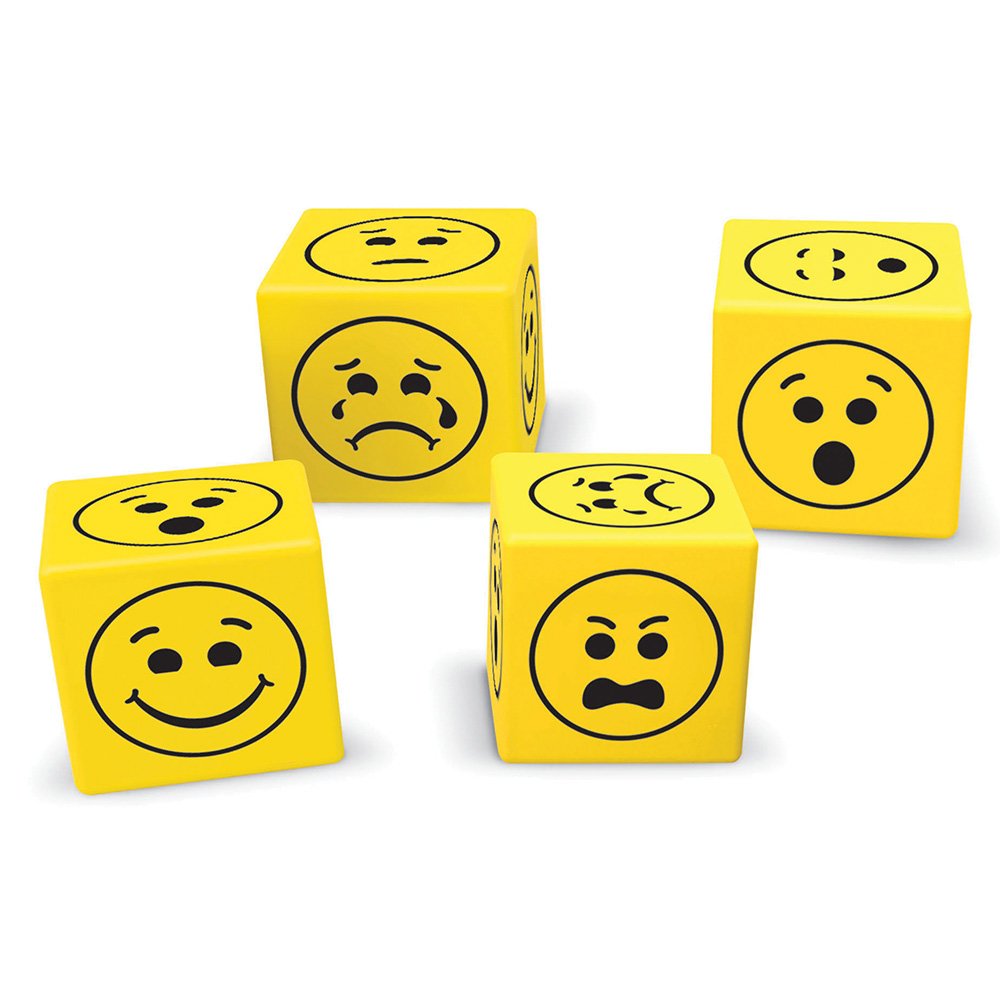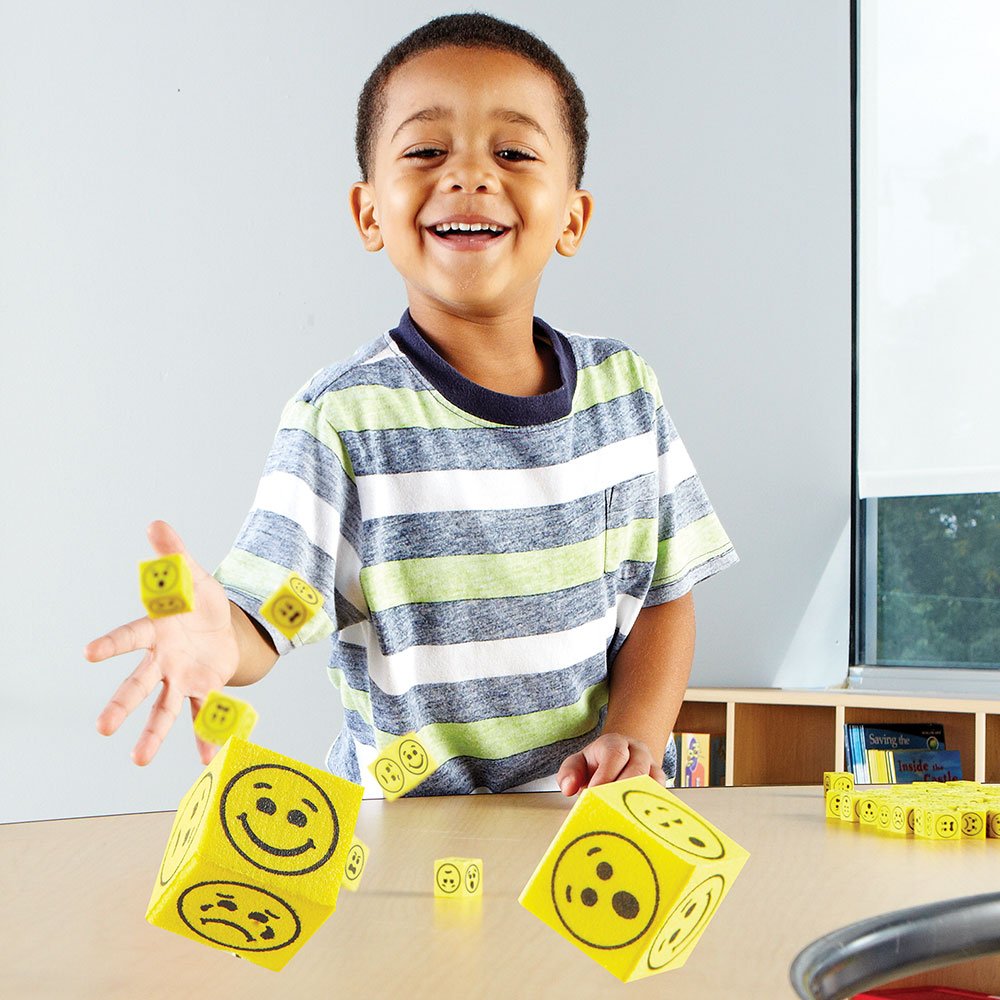Customer Services
Copyright © 2025 Desertcart Holdings Limited
Desert Online General Trading LLC
Dubai, United Arab Emirates





🎉 Roll into Emotional Learning!
The Learning Resources Soft Foam Emoji Dice set includes 200 soft foam dice, each measuring 1.5cm, featuring a variety of modern emoji designs that help introduce emotional awareness in educational settings. Ideal for children aged 3 and up, this versatile tool is perfect for both classroom and small group activities.
Z**S
Colourful and tactile
More of a nursery/classroom teaching aid than a home one really, at 200 pieces. Come in a nice storage jar and the quality of dice is very good- soft foam that takes some wear, colourful and tactile with a range of emojis on each. Good, basic teaching resource.
S**E
Rather basic
These are very handy for me as a grown-up. No longer do I have to wonder what mood I’m going to wake up in when I get out of bed in the morning. I can just roll one of these, to tell me what mood to be in, and that’s me set for the rest of the day!But seriously… This very specialised set of 200 dice seems to be specifically targeting classroom environments where topics relating to emotions are being discussed- perhaps in more specialised environments like autistic aids, or maybe as a general classroom aid. In any case, they’ve just got one single function- to show a random emotion. There are no “instructions” or educational guides associated with it so it’s entirely up to the grown-up or teacher to give them the context.They are just light foam cubes. The manufacturing quality is OK- some of the faces are a bit off-centre, but there’s no duff ones. The hexagonal tub is basic but functional. 200 pieces in one tub seems like overkill even in a classroom environment, but they are quite small and likely to go astray, but even so, 200 seems excessive. Surely a small pot of 100 would’ve been enough.I’m not convinced by the illustrations. For one thing I agree with the reviewer ‘Neil’ who says there are too many negative faces. The faces, as interpreted by our 3-year-old, are “happy”, “cry-y” (the sad one with tears), “sad” (the nervous-looking one), “frightened”, “angry”, and “sleepy”. In old terms that’s 1 positive, 1 neutral and 4 negative emotions. Admittedly it’s hard to show more positive options pictorially but it does end up seeming a bit anger-and-sadness heavy. Also I think, as my 3-year-old demonstrated, there’s a definite ambiguity in a couple of the expressions.For what they are, I think they’re really expensive- I would’ve guessed they would cost about ten quid, my wife guessed they would be priced at 15 pounds. Because they’ve got the words “Learning Resources” on the box, some companies seem to use that as an excuse to put a higher price on items, a bit like how the word “wedding” makes the same cake twice as expensive.
B**S
Emo Dice
I’m a fan of various dice-based games and RPGs, so I thought these would be an interesting novelty item – perhaps even useful for randomly generating moods or emotions for Non-Player Characters or the like. They’re intended as an educational aide, though there aren’t any particular instructions for their use. I imagine you could ask children to select how a given character – real or fictional – might feel in a particular circumstance. The range of emotions on offer is quite limited though.You get quite a lot of dice, but they’re all the same. There are six different faces/emotions depicted. There is no official key, but I had a go at deciphering what these are supposed to be (see photo for labels). I’m not sure whether I’m right or not. For instance, my girlfriend and I both thought that ‘sleepy’ was the best interpretation of the last one, but I’m not sure that sleepy is really an emotion. Other interpretations may be possible.The bright yellow colour is likely attractive to children, as well as being commonly used for emojis (at least the smiley ones). As you can see from the photos, some of the faces are rather off-centre, though this isn’t really a problem. I didn’t see any that were cut off the edge of the dice. The dice are made of a soft foam, which can be squidged a bit (see photo – though this took a bit of effort).This means they’re unlikely to damage anything as they get thrown around, which is quite useful as regular dice can knock figures flying quite easily. However, they don’t really roll like dice. You can still generate random results just by shaking them (in your hand or a cup) and tipping them out, but they don’t tumble much across the table top.Though various possible uses suggest themselves, I have to admit that I can’t really think of good uses for so many unless in a school or similar environment. For home use, a much smaller set would probably suffice, but perhaps you could split this with friends or family.
H**S
INTERESTING BUT A LITTLE ONE DIMENTIONAL AS A TEACHING AID.
Passed them on to my other half to take into school. She looked at them and asked if there was any information leaflet on how to use them or what different uses they could be put to or even some kind of guide. I explained they were emoji dice, to help discuss emotions and that's about it.She didn't look too impressed but took them with her.Luckily there are two hundred of them because they are easily misplaced. First impression with the children in the class was "wow emoji dice", then after a few minutes the novelty wore off.However with a bit of perseverance a game was invented where each player took three dice and tried to roll a set of three identical faces, which statistically is actually quite difficult. Whatever they rolled the children were asked what expression on each face showed and asked if they ever felt like that and what face would they prefer to roll. The game became quite competitive and the children that were unable to roll an identical 3 faces got more and more obsessed with trying to. Maybe they can be used to show the futility in gambling to teenagers?Another games was where each child took one dice and rolled it then stood together in a group with those who rolled the same face. They then used that as part maths lesson part performing arts as they acted out the emotion. As most children appeared to throw a happy face there was a consensus that there was some cheating going on.Anyway, it was an interesting interlude, they have been left at school and one or two still like to compete in rolling the dice, but they are rather one dimensional, proverbially speaking that is. The 6 faces are a little limited.
Trustpilot
1 month ago
3 weeks ago
2 months ago
1 day ago